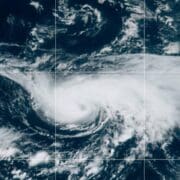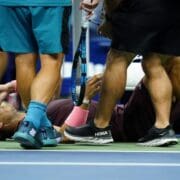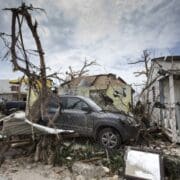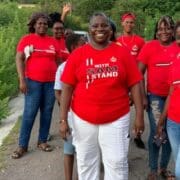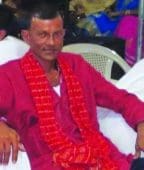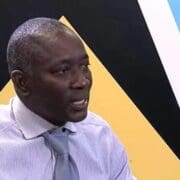Black Immigrant Daily News
The first Category 5 storm of the 2017 season was Hurricane Irma, which formed on Aug. 30, 2017 and dissipated on Sept. 13. For those of you who are meteorology-minded, here is a portion of the National Hurricane Center’s “Tropical Cyclone Report” on Hurricane Irma, as applicable to the Caribbean.
By early on 4 September, Irma’s eye was growing in size and becoming better defined, and deep convection around the eye was gaining symmetry. Irma was on a strengthening trend once again, likely due to the completion of an eyewall replacement cycle, and it was headed toward the northern Leeward Islands. Irma turned west-northwestward, due to the erosion of the western side of the mid-level ridge (Fig 5b), and went through another round of rapid intensification. The hurricane reached its maximum intensity of 155 kt around 1800 UTC 5 September, when it was located about 70 n mi east-southeast of Barbuda. As a category 5 hurricane, Irma made landfall on Barbuda around 0545 UTC 6 September with maximum winds of 155 kt and a minimum pressure of 914 mb (Fig. 6a).
After crossing Barbuda, Irma continued to exhibit an impressive satellite appearance and made its second landfall on St. Martin at 1115 UTC that day, with the same wind speed and pressure as for its Barbuda landfall. Still moving west-northwestward to the south of a mid-level ridge, Irma made its third landfall on the island of Virgin Gorda in the British Virgin Islands at 1630 UTC 6 September still as a 155-kt category 5 hurricane. Later that day, as Irma moved away from the Virgin Islands, reconnaissance data from the Air Force indicated that the major hurricane had weakened slightly and had a double wind maximum, indicative of concentric eyewalls. The double eyewall structure was also evident in Doppler radar data from San Juan, Puerto Rico (Fig. 7)
Even though Irma was no longer at its peak intensity, it remained a category 5 hurricane with a larger wind field than it had previously (Fig. 4). The eye of Irma tracked about 50 n mi to the north of the northern shore of Puerto Rico and the Dominican Republic from 1800 UTC 6 September to 1800 UTC 7 September, with the strongest winds to the north of the center.
The eye of Irma passed just south of the Turks and Caicos Islands around 0000 UTC 8 September, and it made landfall on Little Inagua Island in the Bahamas at 0500 UTC that day at category 4 intensity, with estimated maximum winds of 135 kt and a minimum pressure of 924 mb. This slight weakening ended Irma’s 60-h period of sustained category 5 intensity, which is the second longest such period on record (behind the 1932 Cuba Hurricane of Santa Cruz del Sur). Irma then turned slightly to the left, due to a building subtropical ridge, and moved toward the northern coast of Cuba (Fig. 5c). Reconnaissance and microwave data indicate that the inner core had become better organized, and it is estimated that Irma strengthened to a category 5 hurricane again around 1800 UTC 8 September, only 18 h after weakening below that threshold.
Irma then intensified a little more and made its fifth landfall near Cayo Romano, Cuba, at 0300 UTC 9 September, with estimated maximum winds of 145 kt (Fig. 6b). This marked the first category 5 hurricane landfall in Cuba since Huracan sin Precedentes in 1924. Irma tracked along the Cuban Keys throughout that day, and its interaction with land caused it to weaken significantly, first to a category 4 storm a few hours after landfall in the Cuban Keys and then down to a category 2 hurricane by 1800 UTC that day when the eye was very near Isabela de Sagua. Shortly after that time, the forward speed of Irma slowed, and it began to make a turn to the northwest, which caused the core of the hurricane to move over the Florida Straits early on 10 September.
On Sept 7, 2017, NPR’s Scott Neuman chronicled the damage, going from island to island, tracking Irma’s path.
A string of tiny Caribbean islands have been left stunned and devastated by the destructive force of Hurricane Irma, one of the strongest storms ever to hit the region. Some islands appear to have been spared, but others suffered loss of life and damage on a near-apocalyptic scale.
He started with Antigua and Barbuda.
In Barbuda, communications were severed as Irma made landfall just before midnight on Tuesday. Antigua, 25 miles to the south, dodged the full force of the storm, prompting Prime Minister Gaston Browne at first to declare it a miracle that his nation had been spared.
But as it turned out, Browne had spoken too soon. It was only after communication began to be restored and he was able to visit Barbuda that the damage to the smaller of the two islands became clear. “I journeyed to Barbuda this afternoon and what I saw was heart-wrenching, absolutely devastating,” Browne said on state-owned television Wednesday afternoon. “In fact, I believe that on a per capita basis, the extent of the destruction in Barbuda is unprecedented. And it is unprecedented, based on the type of storm. Hurricane Irma would have been easily the most powerful hurricane to have stormed through the Caribbean, and it is extremely unfortunate that Barbuda was right in its path.”
As noted by Prime Minister Browne below, at least 95% of the island was affected.
One of the most irritating (read: rage-inducing) things about the first reports on Irma were the large number of social media posts from people who mistook Barbuda for Barbados, and posted videos like the one below—videos that were not even hurricane footage.
This post pointed out the geographical distance between the two countries, after a journalist for a Charlotte CBS affiliate made the same error.
On Sept. 11, the BBC reported on damage to St. Martin, St Barts, and Anguilla.
The hurricane left more than two-thirds of homes on the Dutch side of the island of St Martin uninhabitable, with no electricity, gas or drinking water, and four people confirmed dead. The French government has said its side of St Martin – known as Saint-Martin – has sustained about €1.2bn ($1.44bn; £1.1bn) in damage, with nine deaths across Saint-Martin and St Barts. French Interior Minister Gerard Collomb said there had been “massive destruction” to the islands.
The nearby British overseas territory of Anguilla also had extensive damage, with one person killed.
Then Irma hit close to home, making landfall in the Virgin Islands.
Overhead footage offered just a glimpse of how bad things were.
As Colin Dwyer wrote for NPR on Sept. 14:
Hurricane Irma arrived on the doorstep of the Virgin Islands just over a week ago. A Category 5 storm, historic in its terrible might, Irma shredded homes and hotels into the bare materials that made them, its winds scattering floorboards and roofs and light poles like so many matchsticks.
Within a day, the storm had rendered the islands so unrecognizable, satellites could register the stark change from space. Where once the Virgin Islands — both U.S. and British — gleamed green in their lush vegetation, that vista is buried brown beneath uprooted trees and the debris of broken buildings.
As nightmarish as those hours were, the days since have seemed a lifetime for many residents of the U.S. and British territories.
“While there were some homes that survived — some lost just roofs — there are homes that are totally obliterated right down to the foundation,” David Mapp, executive director of the Virgin Islands Port Authority, tells NPR’s Jason Beaubien. “I mean, all you see is rubble.”
This short PBS video offers a glimpse of life after the destruction to the USVI.
In an in-depth segment called “The Forgotten Americans,” Democracy Now! raised questions about the U.S. media’s coverage—or rather, lack thereof—of the devastation to the U.S. territory.
As the video’s YouTube caption explains:
Hurricane Irma made landfall in the U.S. Virgin Islands as a Category 5 storm just over one week ago, knocking out electricity and running water, and cutting off communications with the outside world. Now, Governor Kenneth Mapp says the islands of Saint John and Saint Thomas are still nearly entirely without power. The hurricane also destroyed schools and the main hospital on Saint Thomas. The devastation was so extensive, it can be seen from space. Earlier this week, a U.S. military amphibious ship arrived on Saint Thomas ladened with equipment and supplies. The islands have also received emergency aid from residents of the nearby island of Puerto Rico, where volunteers banded together to collect supplies and transport them on dozens of ships.
But while Hurricane Irma hit the U.S. Virgin Islands days before it made landfall on the Florida Keys, the Virgin Islands have been largely forgotten in the wall-to-wall U.S. media coverage of the storm. And that omission is even more striking given that the U.S. Virgin Islands are in the midst of celebrating their centennial as U.S. territory. We speak with Saint Thomas native Tiphanie Yanique, award-winning poet and novelist. She’s an associate professor in the English Department at Wesleyan University and the author of the poetry collection “Wife” and the novel “Land of Love and Drowning.”
Meanwhile, on Fox (not) News, Tucker Carlson attacked USVI Gov. Mapp, based on NRA claims that Mapp’s calling up the National Guard to respond to the disaster included “seizing citizens’ guns.”
Mapp is the same governor then-President Trump mistakenly called “the president of the Virgin Islands.” It wasn’t until Oct. 3—about a month after Irma made landfall—that Trump actually met with him.
Many U.S. television viewers got their first introduction to USVI Rep. Stacey Plaskett, who went on to be an House manager during Trump’s first impeachment trial; she’s seen here on MSNBC on Sept. 8, 2017.
Perhaps the most high-profile face to step up rally relief for the USVI was retired NBA star Tim Duncan.
Michael C. Wright reported on Duncan’s “amazing” efforts for ESPN.
SAN ANTONIO — Retired San Antonio Spurs forward Tim Duncan called the response to his plea Friday for donations toward Hurricane Irma relief efforts in the U.S. Virgin Islands “amazing,” adding that thousands of donors, including the Spurs, local grocery store chain H-E-B and the San Antonio Food Bank, have contributed.
“I’m blown away by it,” Duncan said Sunday during a news conference at the San Antonio Food Bank. “In this day and age, it’s a little easier to reach a lot of people, and people have come out from everywhere. I’ve looked down the list of donors, and I’ve recognized some names. I’ve gotten support from the Spurs, H-E-B and the food bank — all across the board. It’s just been an amazing response.”
Duncan penned an impassioned plea for donations toward Hurricane Irma relief efforts Friday in The Players’ Tribune, and by Sunday afternoon, he had reached his $1 million goal. Duncan promised that every dollar donated would go directly toward relief efforts on the ground. Duncan kick-started the fundraising effort with a YouCaring account and an immediate $250,000 contribution, and he pledged to match all donations up to the first $1 million.
Post-Irma, Daily Kos Community member Lefty Coaster documented his work helping the USVI rebuild in early 2019, posting at both the beginning and after the conclusion of his three weeks of service.
Tiny Barbuda, which was completely destroyed, is now facing a different set of problems. A “post-hurricane land grab” has been reported by Alleen Brown for The Intercept, involving billionaire developer (and Patrón Tequila co-founder) John Paul DeJoria and movie star Robert de Niro.
Residents of the tiny Caribbean island of Barbuda say a planned luxury resort co-owned by the billionaire philanthropist and self-proclaimed environmentalist John Paul DeJoria could destroy the islanders’ way of life. DeJoria’s development company would place a golf course and community of seaside vacation homes on top of a wetland protected by an international treaty.
Recognized as vital in a future marked by climate crisis, the lagoon’s mangroves, seagrass beds, and coral reefs support a lobster fishery, endangered hawksbill and leatherback turtles, and the largest nesting colony of magnificent frigatebirds in the Western hemisphere. The vegetation also helps protect land from eroding during increasingly severe storms, such as Hurricane Irma, which destroyed the island in 2017.
Locals, who are citizens of the sovereign nation of Antigua and Barbuda, are also raising concerns that the resort constructed by DeJoria’s company Peace, Love and Happiness is playing a role in upending the island’s collective land ownership system, which has survived since slavery’s abolishment.
[…]
The project is one of two large developments — for tiny Barbuda, at least — to benefit from a series of disaster capitalism-style legal maneuvers advanced in the aftermath of Hurricane Irma, as Barbudans fled wholesale destruction. The other project is being led by actor and hotelier Robert De Niro, who plans to build a tony resort called Nobu Beach Inn on a different stretch of sand. Though the Nobu Beach Inn will not be located on the Codrington Lagoon, locals have decried both projects as part of a “land grab” — enabled by a pro-development government in Antigua that lured the resorts in and rammed through a post-hurricane change in land laws that turned the projects into significantly more attractive investments.
The impact of these new luxuries worries Barbudans.
We’ll keep you posted.
In the meantime, cross your fingers and hope that the Caribbean makes it through this season with no major storms.
Join me in the comments to share your memories of Irma, and for the weekly Caribbean News Roundup.
NewsAmericasNow.com

